Jing Xu
refer to the report for detailed contributions
Virtual-Real Collaborated Split Learning via Model Partitioning in IRS-Assisted IoT Networks
Oct 30, 2025Abstract:This paper investigates a novel computation and communication co-design framework for large-scale split learning in intelligent reflecting surface (IRS)-assisted internet of things (IoT) networks integrated with digital twin (DT) technique. The considered system consists of a multi-antenna access point (AP), multiple heterogeneous user devices (UDs), and an deployed IRS to enhance both uplink and downlink transmission. The training process of a deep neural network is partitioned between devices and the AP, where a DT replica is activated to replace UDs with insufficient local computation capabilities. We formulate a delay-optimal split learning problem, which optimizes five key variables: layer partitioning points, DT assignment decisions, IRS phase shift matrix, AP downlink power allocation, and DT frequency adjustment, aiming to minimize the overall end-to-end delay under communication and computation. The proposed optimization problem is a highly coupled non-convex mixed-integer problem. Therefore, we solve using an alternating optimization approach combining closed-form updates, semidefinite relaxation (SDR), and low-complexity heuristics. Extensive simulations demonstrate that the proposed scheme significantly reduces training delay compared to conventional baselines and achieves up to 35\% delay improvement, especially under high UD density and stringent power constraints.
Probing the Representational Geometry of Color Qualia: Dissociating Pure Perception from Task Demands in Brains and AI Models
Oct 26, 2025Abstract:Probing the computational underpinnings of subjective experience, or qualia, remains a central challenge in cognitive neuroscience. This project tackles this question by performing a rigorous comparison of the representational geometry of color qualia between state-of-the-art AI models and the human brain. Using a unique fMRI dataset with a "no-report" paradigm, we use Representational Similarity Analysis (RSA) to compare diverse vision models against neural activity under two conditions: pure perception ("no-report") and task-modulated perception ("report"). Our analysis yields three principal findings. First, nearly all models align better with neural representations of pure perception, suggesting that the cognitive processes involved in task execution are not captured by current feedforward architectures. Second, our analysis reveals a critical interaction between training paradigm and architecture, challenging the simple assumption that Contrastive Language-Image Pre-training(CLIP) training universally improves neural plausibility. In our direct comparison, this multi-modal training method enhanced brain-alignment for a vision transformer(ViT), yet had the opposite effect on a ConvNet. Our work contributes a new benchmark task for color qualia to the field, packaged in a Brain-Score compatible format. This benchmark reveals a fundamental divergence in the inductive biases of artificial and biological vision systems, offering clear guidance for developing more neurally plausible models.
Hybrid Reinforcement: When Reward Is Sparse, It's Better to Be Dense
Oct 08, 2025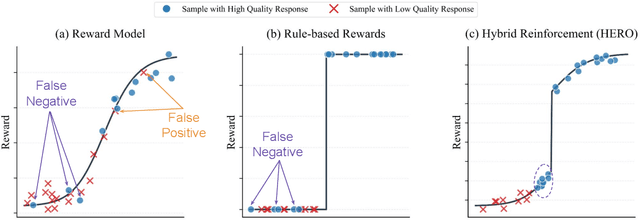
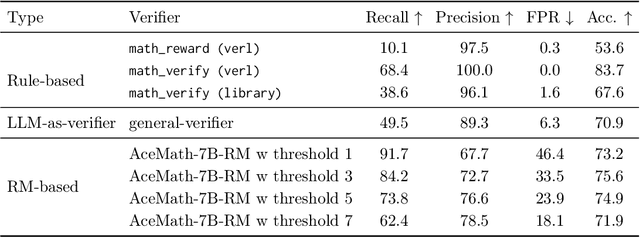
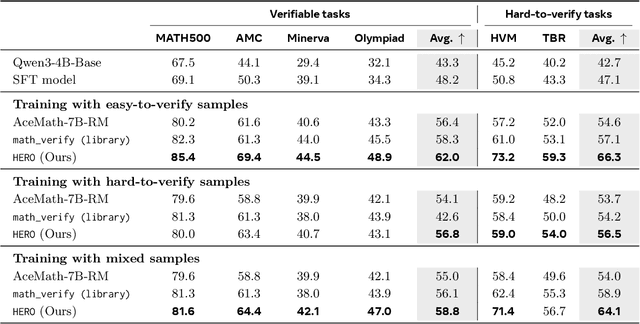

Abstract:Post-training for reasoning of large language models (LLMs) increasingly relies on verifiable rewards: deterministic checkers that provide 0-1 correctness signals. While reliable, such binary feedback is brittle--many tasks admit partially correct or alternative answers that verifiers under-credit, and the resulting all-or-nothing supervision limits learning. Reward models offer richer, continuous feedback, which can serve as a complementary supervisory signal to verifiers. We introduce HERO (Hybrid Ensemble Reward Optimization), a reinforcement learning framework that integrates verifier signals with reward-model scores in a structured way. HERO employs stratified normalization to bound reward-model scores within verifier-defined groups, preserving correctness while refining quality distinctions, and variance-aware weighting to emphasize challenging prompts where dense signals matter most. Across diverse mathematical reasoning benchmarks, HERO consistently outperforms RM-only and verifier-only baselines, with strong gains on both verifiable and hard-to-verify tasks. Our results show that hybrid reward design retains the stability of verifiers while leveraging the nuance of reward models to advance reasoning.
RESTRAIN: From Spurious Votes to Signals -- Self-Driven RL with Self-Penalization
Oct 02, 2025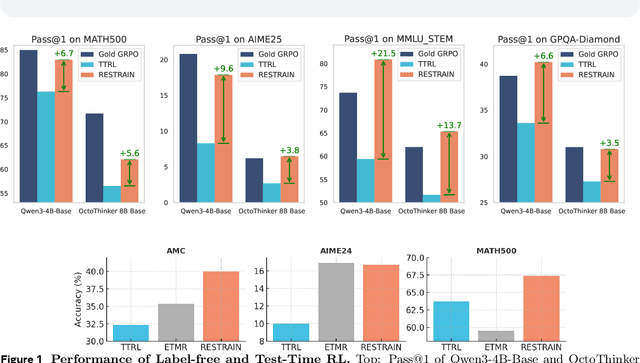
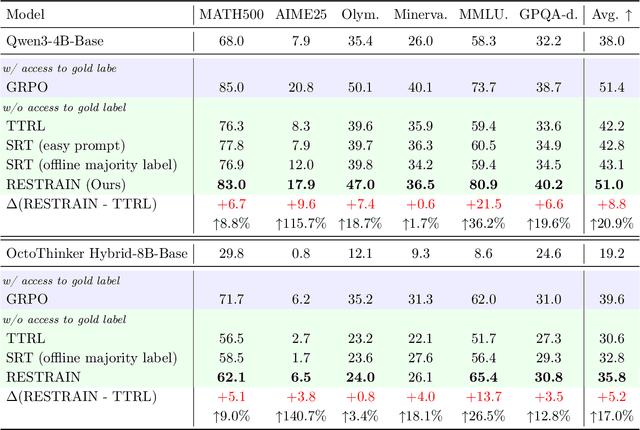

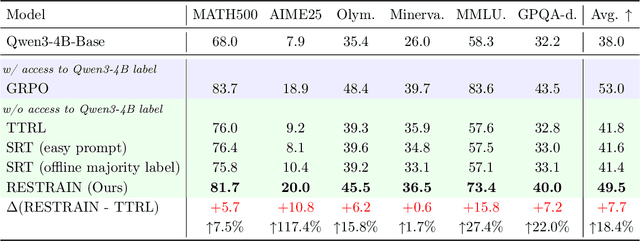
Abstract:Reinforcement learning with human-annotated data has boosted chain-of-thought reasoning in large reasoning models, but these gains come at high costs in labeled data while faltering on harder tasks. A natural next step is experience-driven learning, where models improve without curated labels by adapting to unlabeled data. We introduce RESTRAIN (REinforcement learning with Self-restraint), a self-penalizing RL framework that converts the absence of gold labels into a useful learning signal. Instead of overcommitting to spurious majority votes, RESTRAIN exploits signals from the model's entire answer distribution: penalizing overconfident rollouts and low-consistency examples while preserving promising reasoning chains. The self-penalization mechanism integrates seamlessly into policy optimization methods such as GRPO, enabling continual self-improvement without supervision. On challenging reasoning benchmarks, RESTRAIN delivers large gains using only unlabeled data. With Qwen3-4B-Base and OctoThinker Hybrid-8B-Base, it improves Pass@1 by up to +140.7 percent on AIME25, +36.2 percent on MMLU_STEM, and +19.6 percent on GPQA-Diamond, nearly matching gold-label training while using no gold labels. These results demonstrate that RESTRAIN establishes a scalable path toward stronger reasoning without gold labels.
Hunyuan3D Studio: End-to-End AI Pipeline for Game-Ready 3D Asset Generation
Sep 16, 2025



Abstract:The creation of high-quality 3D assets, a cornerstone of modern game development, has long been characterized by labor-intensive and specialized workflows. This paper presents Hunyuan3D Studio, an end-to-end AI-powered content creation platform designed to revolutionize the game production pipeline by automating and streamlining the generation of game-ready 3D assets. At its core, Hunyuan3D Studio integrates a suite of advanced neural modules (such as Part-level 3D Generation, Polygon Generation, Semantic UV, etc.) into a cohesive and user-friendly system. This unified framework allows for the rapid transformation of a single concept image or textual description into a fully-realized, production-quality 3D model complete with optimized geometry and high-fidelity PBR textures. We demonstrate that assets generated by Hunyuan3D Studio are not only visually compelling but also adhere to the stringent technical requirements of contemporary game engines, significantly reducing iteration time and lowering the barrier to entry for 3D content creation. By providing a seamless bridge from creative intent to technical asset, Hunyuan3D Studio represents a significant leap forward for AI-assisted workflows in game development and interactive media.
Memorization in Graph Neural Networks
Aug 26, 2025

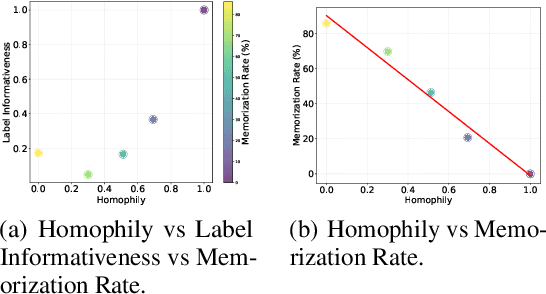
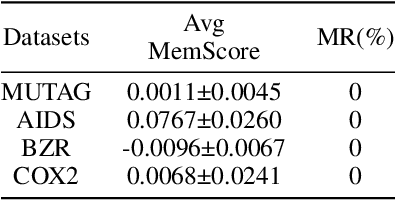
Abstract:Deep neural networks (DNNs) have been shown to memorize their training data, yet similar analyses for graph neural networks (GNNs) remain largely under-explored. We introduce NCMemo (Node Classification Memorization), the first framework to quantify label memorization in semi-supervised node classification. We first establish an inverse relationship between memorization and graph homophily, i.e., the property that connected nodes share similar labels/features. We find that lower homophily significantly increases memorization, indicating that GNNs rely on memorization to learn less homophilic graphs. Secondly, we analyze GNN training dynamics. We find that the increased memorization in low homophily graphs is tightly coupled to the GNNs' implicit bias on using graph structure during learning. In low homophily regimes, this structure is less informative, hence inducing memorization of the node labels to minimize training loss. Finally, we show that nodes with higher label inconsistency in their feature-space neighborhood are significantly more prone to memorization. Building on our insights into the link between graph homophily and memorization, we investigate graph rewiring as a means to mitigate memorization. Our results demonstrate that this approach effectively reduces memorization without compromising model performance. Moreover, we show that it lowers the privacy risk for previously memorized data points in practice. Thus, our work not only advances understanding of GNN learning but also supports more privacy-preserving GNN deployment.
Adversarial Attacks and Defenses on Graph-aware Large Language Models (LLMs)
Aug 06, 2025Abstract:Large Language Models (LLMs) are increasingly integrated with graph-structured data for tasks like node classification, a domain traditionally dominated by Graph Neural Networks (GNNs). While this integration leverages rich relational information to improve task performance, their robustness against adversarial attacks remains unexplored. We take the first step to explore the vulnerabilities of graph-aware LLMs by leveraging existing adversarial attack methods tailored for graph-based models, including those for poisoning (training-time attacks) and evasion (test-time attacks), on two representative models, LLAGA (Chen et al. 2024) and GRAPHPROMPTER (Liu et al. 2024). Additionally, we discover a new attack surface for LLAGA where an attacker can inject malicious nodes as placeholders into the node sequence template to severely degrade its performance. Our systematic analysis reveals that certain design choices in graph encoding can enhance attack success, with specific findings that: (1) the node sequence template in LLAGA increases its vulnerability; (2) the GNN encoder used in GRAPHPROMPTER demonstrates greater robustness; and (3) both approaches remain susceptible to imperceptible feature perturbation attacks. Finally, we propose an end-to-end defense framework GALGUARD, that combines an LLM-based feature correction module to mitigate feature-level perturbations and adapted GNN defenses to protect against structural attacks.
CoT-Self-Instruct: Building high-quality synthetic prompts for reasoning and non-reasoning tasks
Jul 31, 2025Abstract:We propose CoT-Self-Instruct, a synthetic data generation method that instructs LLMs to first reason and plan via Chain-of-Thought (CoT) based on the given seed tasks, and then to generate a new synthetic prompt of similar quality and complexity for use in LLM training, followed by filtering for high-quality data with automatic metrics. In verifiable reasoning, our synthetic data significantly outperforms existing training datasets, such as s1k and OpenMathReasoning, across MATH500, AMC23, AIME24 and GPQA-Diamond. For non-verifiable instruction-following tasks, our method surpasses the performance of human or standard self-instruct prompts on both AlpacaEval 2.0 and Arena-Hard.
Kimi K2: Open Agentic Intelligence
Jul 28, 2025Abstract:We introduce Kimi K2, a Mixture-of-Experts (MoE) large language model with 32 billion activated parameters and 1 trillion total parameters. We propose the MuonClip optimizer, which improves upon Muon with a novel QK-clip technique to address training instability while enjoying the advanced token efficiency of Muon. Based on MuonClip, K2 was pre-trained on 15.5 trillion tokens with zero loss spike. During post-training, K2 undergoes a multi-stage post-training process, highlighted by a large-scale agentic data synthesis pipeline and a joint reinforcement learning (RL) stage, where the model improves its capabilities through interactions with real and synthetic environments. Kimi K2 achieves state-of-the-art performance among open-source non-thinking models, with strengths in agentic capabilities. Notably, K2 obtains 66.1 on Tau2-Bench, 76.5 on ACEBench (En), 65.8 on SWE-Bench Verified, and 47.3 on SWE-Bench Multilingual -- surpassing most open and closed-sourced baselines in non-thinking settings. It also exhibits strong capabilities in coding, mathematics, and reasoning tasks, with a score of 53.7 on LiveCodeBench v6, 49.5 on AIME 2025, 75.1 on GPQA-Diamond, and 27.1 on OJBench, all without extended thinking. These results position Kimi K2 as one of the most capable open-source large language models to date, particularly in software engineering and agentic tasks. We release our base and post-trained model checkpoints to facilitate future research and applications of agentic intelligence.
NeuralDB: Scaling Knowledge Editing in LLMs to 100,000 Facts with Neural KV Database
Jul 24, 2025Abstract:Efficiently editing knowledge stored in large language models (LLMs) enables model updates without large-scale training. One possible solution is Locate-and-Edit (L\&E), allowing simultaneous modifications of a massive number of facts. However, such editing may compromise the general abilities of LLMs and even result in forgetting edited facts when scaling up to thousands of edits. In this paper, we model existing linear L\&E methods as querying a Key-Value (KV) database. From this perspective, we then propose NeuralDB, an editing framework that explicitly represents the edited facts as a neural KV database equipped with a non-linear gated retrieval module, % In particular, our gated module only operates when inference involves the edited facts, effectively preserving the general abilities of LLMs. Comprehensive experiments involving the editing of 10,000 facts were conducted on the ZsRE and CounterFacts datasets, using GPT2-XL, GPT-J (6B) and Llama-3 (8B). The results demonstrate that NeuralDB not only excels in editing efficacy, generalization, specificity, fluency, and consistency, but also preserves overall performance across six representative text understanding and generation tasks. Further experiments indicate that NeuralDB maintains its effectiveness even when scaled to 100,000 facts (\textbf{50x} more than in prior work).
 Add to Chrome
Add to Chrome Add to Firefox
Add to Firefox Add to Edge
Add to Edge